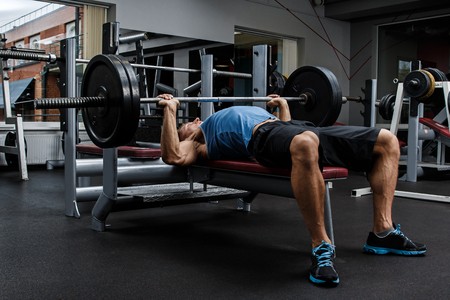
Click Here for Free Bodybuilding and Fitness Magazine Subscription
The Powerlifter's Guide to Muscle Building: Training Techniques and Strategies

If you're a powerlifter, you know that strength is critical for lifting heavier weights and achieving better results in competitions. But did you know that muscle building is equally important? Not only can it help you lift heavier weights, but it can also reduce your risk of injury and improve your overall physical performance.
In this article, we'll explore the benefits of muscle building specifically for powerlifters. We'll discuss effective training techniques and strategies that can help you build muscle and become a more well-rounded powerlifter. Plus, we'll cover the importance of proper nutrition, hydration, and recovery for muscle growth.
Basics of Muscle Building for Powerlifters
First, it is essential to understand muscle hypertrophy. It is the process of increasing the size and volume of muscle fibers through resistance training. It requires two things: stress and recovery.
During a workout, your muscles experience stress, causing microscopic tears in the muscle fibers. Meanwhile, in the recovery process, your body repairs these tears, causing the muscles to grow stronger and bigger.
To promote muscle hypertrophy, powerlifters need to focus on proper nutrition and recovery in addition to strength training. This means consuming enough calories and protein to support muscle growth, as well as getting adequate rest to allow your body to recover between workouts.
It's also important to note that muscle building and strength training are closely related. Building muscle can help you lift heavier weights, but lifting heavier weights can also promote muscle growth.
Training Techniques for Muscle Building
One of the most important principles of muscle building is progressive overload. This means gradually increasing the weight, volume, or intensity of your workouts over time. By doing so, you can continue to challenge your muscles.
Here are some specific training techniques that can promote muscle hypertrophy:
Volume Training: This involves performing a high number of sets and reps with moderate weight to induce muscle fatigue and promote hypertrophy.
High-Intensity Interval Training: It is all about alternating periods of high-intensity exercise with periods of rest or low-intensity exercise. High-intensity training can promote muscle growth while also improving cardiovascular health.
Supersets: It requires performing two exercises back-to-back without rest. This technique can help you increase the volume of your workouts and promote muscle growth.
Strategies for Powerlifters to Build Muscle
While powerlifters prioritize strength training, there are several strategies you can implement to focus on building muscle. One effective to do so as a powerlifter is to incorporate bodybuilding exercises into your routine. These are designed to promote muscle growth and can complement powerlifting exercises by targeting different muscle groups.
Here are some specific strategies you can use to build muscle as a powerlifter:
Prioritize Compound Exercises: Squats, deadlifts, and bench presses can be the foundations of your routine. These compound exercises target multiple muscle groups and promote both strength and muscle growth.
Incorporate Isolation Exercises: From bicep curls to leg extensions, isolation exercises can help you target specific muscle groups that may not be as heavily worked during compound exercises.
Increase Time Under Tension: It refers to the amount of time your muscles are under stress during a workout. By slowing down the tempo of your lifts and focusing on the eccentric (lowering) phase of the movement, you can increase time under tension and promote muscle growth.
Nutrition and Hydration for Muscle Building
Here are some tips for nutrition and hydration to support muscle building:
Calculate Your Caloric Needs: You need to consume more calories than you burn. Calculate your daily caloric needs using an online calculator and aim to consume slightly more than this number to promote muscle growth.
Consume Enough Protein: Protein is essential for muscle repair and growth. Aim to consume 1-1.5 grams of protein per pound of body weight per day to support muscle building.
Stay Hydrated: Hydration is crucial for muscle function and repair. More so, according to JUST Water, drinking water can boost energy and prevent fluid loss during workouts, making hydration vital for training. Aim to drink at least 8-10 cups of water per day to stay hydrated and support muscle growth.
Consume Healthy Fats and Carbs: Include healthy fats and carbs in your diet, such as avocados, nuts, sweet potatoes, and whole grains.
Don't Forget About Micronutrients: Make sure to consume a variety of fruits and vegetables to ensure you're getting all the micronutrients your body needs.
Consider Supplements: Nitric oxide supplements are among the most popular. They can help pump your muscles while improving recovery. Whey protein, creatine, and branched-chain amino acids can also help.
Stay Consistent: Consistency is key when it comes to nutrition and hydration for muscle building. Make sure to stick to your meal plan and hydration goals consistently to see results over time.
Recovery and Rest for Muscle Building
During a workout, your muscles experience stress and damage, and recovery time allows your body to repair and rebuild them. Here are some tips to support muscle building:
Get Enough Sleep: Aim to get 7-8 hours of sleep per night to support muscle repair and growth. At the same time, it can aid in recovery.
Take Rest Days: Make sure to incorporate rest days into your routine and avoid overtraining. Give yourself a break.
Use Active Recovery: Stretching and light exercise can help promote muscle recovery and reduce soreness.
Hydrate: As earlier mentioned, drink at least 8-10 glasses of water daily to help you achieve your fitness goals.
Use Recovery Tools: Foam rollers, massage balls, and other recovery tools can help reduce muscle soreness, so your muscles can recover easily.
Conclusion
Building muscle is a crucial component of becoming a stronger and more well-rounded powerlifter. By incorporating effective training techniques, nutrition and hydration strategies, and prioritizing recovery and rest, you can promote muscle growth and become a better powerlifter.

